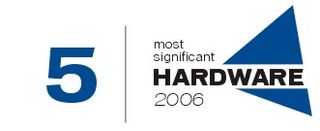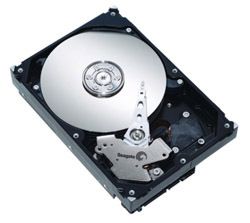TG Daily Top-10: Most significant Hardware of 2006
Seagate Barracuda 7200 (750 GB)

Mark Raby
What is it:
A high capacity hard drive that takes advantage of perpendicular magnetic recording (PMR) technology.
Why we chose it:
Mass storage space, primarily hard drives, is one part of the tech world that you can't get enough of. It never has been a problem for most users to fill up their then-super-sized hard drives with data in an unexpectedly short amount of time. For the past 10 years or so, we have been hearing hard drive manufacturers voicing concerns that the natural barrier of maximum storage density in hard drives would be reached within one or two years. Well, we're still not there yet and PMR has extended the life of the traditional hard drive by another few years.
2006 was the first significant year of the PMR drive (we've just heard that more than 5 million drives were shipped this year.) So, it's a common sense choice for this list. But which drive do you choose? Most impressive, by a long shot, was Fujitsu's recently announced 300 GB (!) 2.5" notebook drive; but it won't ship until Q1 2007. Next down would be Toshiba's 200 GB 2.5" drive, but we felt that Seagate's 750 GB Barracuda, introduced in April, was more significant this year, as it addressed current storage needs.

PC games now take up gigabytes of space, while media enthusiasts rip dozens of hours of video and music from CDs and DVDs to their hard drive. Heck, we're just excited that we're now able to play Doom 3 using picture-in-picture with the entire series of Rocko's Modern Life playing on screen as well, while listening to the complete repertoire of John Tesh, using one hard drive. On a serious note, with videos and audio becoming more important in our everyday life, and HD approaching quickly, the biggest hard drive is just good enough - and that is, by a significant margin, the Seagate Barracuda 7200.
What it means to you:
The move to perpendicular recording is an all-encompassing trend that affects anyone who owns a computer or other hard drive-based device. While not everyone will clamor around a 750 GB hard drive yet, the need for space will continue to grow correspondingly with the growth of technology as a whole, and virtually anything with a hard drive that you are buying now will just have even more space in the future. And technically, 750 GB is not that much - it's barely enough for 15 Blu-ray discs.
Predictions for 2007:
We already know that hard drives with even bigger capacities are headed for 2007. One Terabyte is possible, but it will depend on manufacturers such as Hitachi, Toshiba and Western Digital to increase the pressure in this space on Seagate. We do know that Seagate would be able to roll out a 1 TB hard drive, if there was a (competitive) need for it. 2007 will also bring a new category of hard drives, foremost hybrid hard drives that combine flash memory with traditional hard drive technology, which not only will result in more performance, but also lower power consumption. And then there will be a solid offering of flash hard drives, (initially) expensive hard drive alternatives for ultra-mobile computers with capacities ranging from 32 to 64 GB.
Stay on the Cutting Edge
Join the experts who read Tom's Hardware for the inside track on enthusiast PC tech news — and have for over 25 years. We'll send breaking news and in-depth reviews of CPUs, GPUs, AI, maker hardware and more straight to your inbox.
Article Coverage:
Seagate introduces three-quarter terabyte Barracuda hard drive
Slideshows:


Current page: Seagate Barracuda 7200 (750 GB)
Prev Page Nvidia GeForce 8800 series Next Page Sandisk Sansa e200 seriesMost Popular

